SLAS646C December 2009 – May 2015 DAC3282
PRODUCTION DATA.
- 1 Features
- 2 Applications
- 3 Description
- 4 Revision History
- 5 Pin Configuration and Functions
-
6 Specifications
- 6.1 Absolute Maximum Ratings
- 6.2 ESD Ratings
- 6.3 Recommended Operating Conditions
- 6.4 Thermal Information
- 6.5 Electrical Characteristics - DC Specifications
- 6.6 Electrical Characteristics - AC Specifications
- 6.7 Electrical Characteristics - Digital Specifications
- 6.8 Timing Characteristics
- 6.9 Typical Characteristics
-
7 Detailed Description
- 7.1 Overview
- 7.2 Functional Block Diagram
- 7.3
Feature Description
- 7.3.1 Input FIFO
- 7.3.2 FIFO Alarms
- 7.3.3 FIFO Modes of Operation
- 7.3.4 Dual Sync Sources Mode
- 7.3.5 Single Sync Source Mode
- 7.3.6 Bypass Mode
- 7.3.7 Data Pattern Checker
- 7.3.8 FIR Filters
- 7.3.9 Coarse Mixer
- 7.3.10 Digital Offset Control
- 7.3.11 Temperature Sensor
- 7.3.12 Sleep Modes
- 7.3.13 Reference Operation
- 7.4 Device Functional Modes
- 7.5 Programming
- 7.6
Register Maps
- 7.6.1 CONFIG0 (address = 0x00) [reset = 0x70]
- 7.6.2 CONFIG1 (address = 0x01) [reset = 0x11]
- 7.6.3 CONFIG2 (address = 0x02) [reset = 0x00]
- 7.6.4 CONFIG3 (address = 0x03) [reset = 0x10]
- 7.6.5 CONFIG4 (address = 0x04) [reset = 0xFF]
- 7.6.6 CONFIG5 (address = 0x05) READ ONLY
- 7.6.7 CONFIG6 (address =0x06) [reset = 0x00]
- 7.6.8 CONFIG7 (address = 0x07) [reset = 0x00] (WRITE TO CLEAR)
- 7.6.9 CONFIG8 (address = 0x08) [reset = 0x00] (WRITE TO CLEAR)
- 7.6.10 CONFIG9 (address = 0x09) [reset = 0x7A]
- 7.6.11 CONFIG10 (address = 0x0A) [reset = 0xB6]
- 7.6.12 CONFIG11 (address = 0x0B) [reset = 0xEA]
- 7.6.13 CONFIG12 (address =0x0C) [reset = 0x45]
- 7.6.14 CONFIG13 (address =0x0D) [reset = 0x1A]
- 7.6.15 CONFIG14 Register Name (address = 0x0E) [reset = 0x16]
- 7.6.16 CONFIG15 Register Name (address = 0x0F) [reset = 0xAA]
- 7.6.17 CONFIG16 (address = 0x10) [reset = 0xC6]
- 7.6.18 CONFIG17 (address = 0x11) [reset = 0x00]
- 7.6.19 CONFIG18 (address = 0x12) [reset = 0x02]
- 7.6.20 CONFIG19 (address = 0x13) [reset = 0x00]
- 7.6.21 CONFIG20 (address = 0x14) [reset = 0x00] (CAUSES AUTOSYNC)
- 7.6.22 CONFIG21 (address = 0x15) [reset = 0x00]
- 7.6.23 CONFIG22 (address = 0x16) [reset = 0x00]
- 7.6.24 CONFIG23 (address = 0x17) [reset = 0x00]
- 7.6.25 CONFIG24 (address = 0x18) [reset = 0x83]
- 7.6.26 CONFIG25 (address = 0x19) [reset = 0x00]
- 7.6.27 CONFIG26 (address = 0x1A) [reset = 0x00]
- 7.6.28 CONFIG27 (address =0x1B) [reset = 0x00]
- 7.6.29 CONFIG28 (address = 0x1C) [reset = 0x00]
- 7.6.30 CONFIG29 (address = 0x1D) [reset = 0x00]
- 7.6.31 CONFIG30 (address = 0x1E) [reset = 0x00]
- 7.6.32 VERSION31 (address = 0x1F) [reset = 0x43] (READ ONLY)
- 8 Application and Implementation
- 9 Power Supply Recommendations
- 10Layout
- 11Device and Documentation Support
- 12Mechanical, Packaging, and Orderable Information
6 Specifications
6.1 Absolute Maximum Ratings
over operating free-air temperature range (unless otherwise noted) (1)| MIN | MAX | UNIT | ||
|---|---|---|---|---|
| Supply voltage | DACVDD18(2) | –0.5 | 2.3 | V |
| DIGVDD18(2) | –0.5 | 2.3 | ||
| CLKVDD18(2) | –0.5 | 2.3 | ||
| VFUSE(2) | –0.5 | 2.3 | ||
| AVDD33(2) | –0.5 | 4 | ||
| Terminal voltage | CLKVDD18 to DIGVDD18 | –0.5 | 0.5 | V |
| DACVDD18 to DIGVDD18 | –0.5 | 0.5 | ||
| D[7..0]P ,D[7..0]N, DATACLKP,DATACLKN, FRAMEP, FRAMEN(2) | –0.5 | DIGVDD18 + 0.5 | ||
| DACCLKP, DACCLKN, OSTRP, OSTRN(2) | –0.5 | CLKVDD18 + 0.5 | ||
| ALARM_SDO, SDIO, SCLK, SDENB, RESETB, TXENABLE(2) | –0.5 | DIGVDD18 + 0.5 | ||
| IOUTA1/B1, IOUTA2/B2(2) | –1.0 | AVDD33 + 0.5 | ||
| EXTIO, BIASJ(2) | –0.5 | AVDD33 + 0.5 | ||
| Peak input current (any input) | 20 | mA | ||
| Peak total input current (all inputs) | –30 | mA | ||
| TA | Operating free-air temperature, DAC3282 | –40 | 85 | °C |
| Tstg | Storage temperature | –65 | 150 | °C |
(1) Stresses beyond those listed under Absolute Maximum Ratings may cause permanent damage to the device. These are stress ratings only, which do not imply functional operation of the device at these or any other conditions beyond those indicated under Recommended Operating Conditions. Exposure to absolute-maximum-rated conditions for extended periods may affect device reliability.
(2) Measured with respect to GND.
6.2 ESD Ratings
| VALUE | UNIT | |||
|---|---|---|---|---|
| V(ESD) | Electrostatic discharge | Human-body model (HBM), per ANSI/ESDA/JEDEC JS-001(1) | ±2000 | V |
| Charged-device model (CDM), per JEDEC specification JESD22-C101(2) | ±500 | |||
(1) JEDEC document JEP155 states that 500-V HBM allows safe manufacturing with a standard ESD control process.
(2) JEDEC document JEP157 states that 250-V CDM allows safe manufacturing with a standard ESD control process.
6.3 Recommended Operating Conditions
over operating free-air temperature range (unless otherwise noted)| MIN | NOM | MAX | UNIT | ||
|---|---|---|---|---|---|
| Voltage | 1.8-V DAC core supply voltage, DACDVDD18 | 1.7 | 1.8 | 1.9 | V |
| 1.8-V digital supply voltage, DIGVDD18 | 1.7 | 1.8 | 1.9 | V | |
| 1.8-V internal clock buffer supply voltage, CLKVDD18 | 1.7 | 1.8 | 1.9 | V | |
| 3.3-V analog supply voltage, AVDD33 | 3.0 | 3.3 | 3.6 | V | |
6.4 Thermal Information
| THERMAL METRIC(1) | DAC3282 | UNIT | |
|---|---|---|---|
| RGZ (VQFN) | |||
| 48 PINS | |||
| RθJA | Junction-to-ambient thermal resistance | 26.3 | °C/W |
| RθJC(top) | Junction-to-case (top) thermal resistance | 12.2 | °C/W |
| RθJB | Junction-to-board thermal resistance | 3.7 | °C/W |
| ψJT | Junction-to-top characterization parameter | 0.2 | °C/W |
| ψJB | Junction-to-board characterization parameter | 3.6 | °C/W |
| RθJC(bot) | Junction-to-case (bottom) thermal resistance | 0.7 | °C/W |
(1) For more information about traditional and new thermal metrics, see the Semiconductor and IC Package Thermal Metrics application report, SPRA953.
6.5 Electrical Characteristics – DC Specifications(1)
over recommended operating free-air temperature range, nominal supplies, IOUTFS = 20 mA (unless otherwise noted)| PARAMETER | TEST CONDITIONS | MIN | TYP | MAX | UNIT | |
|---|---|---|---|---|---|---|
| Resolution | 16 | Bits | ||||
| DC ACCURACY | ||||||
| DNL | Differential nonlinearity | 1 LSB = IOUTFS/216 | ±2 | LSB | ||
| INL | Integral nonlinearity | ±4 | LSB | |||
| ANALOG OUTPUT | ||||||
| Coarse gain linearity | ±0.04 | LSB | ||||
| Offset error | Mid code offset | 0.01 | %FSR | |||
| Gain error | With external reference | ±2 | %FSR | |||
| With internal reference | ±2 | %FSR | ||||
| Gain mismatch | With internal reference | –2 | 2 | %FSR | ||
| Minimum full scale output current | Nominal full-scale current, IOUTFS = 16 × IBIAS current. | 2 | mA | |||
| Maximum full scale output current | 20 | |||||
| Output compliance range(2) | IOUTFS = 20 mA | AVDD –0.5V | AVDD +0.5V | V | ||
| Output resistance | 300 | kΩ | ||||
| Output capacitance | 5 | pF | ||||
| REFERENCE OUTPUT | ||||||
| VREF | Reference output voltage | 1.14 | 1.2 | 1.26 | V | |
| Reference output current(3) | 100 | nA | ||||
| REFERENCE INPUT | ||||||
| VEXTIO | Input voltage range | External Reference Mode | 0.1 | 1.2 | 1.25 | V |
| Input resistance | 1 | MΩ | ||||
| Small signal bandwidth | 472 | kHz | ||||
| Input capacitance | 100 | pF | ||||
| TEMPERATURE COEFFICIENTS | ||||||
| Offset drift | ±1 | ppm of FSR/°C | ||||
| Gain drift | With external reference | ±15 | ppm of FSR/°C | |||
| With internal reference | ±30 | |||||
| Reference voltage drift | ±8 | ppm/°C | ||||
| POWER SUPPLY | ||||||
| AVDD33 | 3.0 | 3.3 | 3.6 | V | ||
| DACVDD18, DIGVDD18, CLKVDD18 | 1.7 | 1.8 | 1.9 | V | ||
| I(AVDD33) | Analog supply current | Mode 1(below) | 96 | mA | ||
| I(DIGVDD18) | Digital supply current | 268 | mA | |||
| I(DACVDD18) | DAC supply current | 74 | mA | |||
| I(CLKVDD18) | Clock supply current | 10 | mA | |||
| I(AVDD33) | Power down mode analog supply current | Mode 4 (below) | 2 | mA | ||
| I(DIGVDD18) | Power down mode digital supply current | 3 | mA | |||
| I(DACVDD18) | Power down mode DAC supply current | 0.5 | mA | |||
| I(CLKVDD18) | Power down mode clock supply current | 1 | mA | |||
| P | Power Dissipation | Mode 1: fDAC = 625MSPS, 2x interpolation, mixer on, Digital Offset Control on |
950 | 1100 | mW | |
| Mode 2: fDAC = 491.52MSPS, 2x interpolation, Zero-IF Correction Filter on, mixer off, Digital Offset Control on |
845 | mW | ||||
| Mode 3: Sleep Mode, fDAC = 625MSPS, 2X interpolation, mixer on, DAC in sleep mode: CONFIG24 sleepa, sleepb set to 1 |
575 | mW | ||||
| Mode 4: Power-Down mode, No clock, static data pattern, DAC in power-down mode: CONFIG23 clkpath_sleep_a, clkpath_sleepb set to 1 CONFIG24 clkrecv_sleep, sleepa, sleepb set to 1 |
15 | mW | ||||
| PSRR | Power Supply Rejection Ratio | DC tested | –0.4 | 0.4 | %/FSR/V | |
| T | Operating Range | –40 | 25 | 85 | °C | |
(1) Measured differential across IOUTA1 and IOUTA2 or IOUTB1 and IOUTB2 with 25 Ω each to AVDD.
(2) The lower limit of the output compliance is determined by the CMOS process. Exceeding this limit may result in transistor breakdown, resulting in reduced reliability of the DAC3282 device. The upper limit of the output compliance is determined by the load resistors and full-scale output current. Exceeding the upper limit adversely affects distortion performance and integral nonlinearity.
(3) Use an external buffer amplifier with high impedance input to drive any external load.
6.6 Electrical Characteristics – AC Specifications
over recommended operating free-air temperature range, nominal supplies, IOUTFS = 20 mA (unless otherwise noted)| PARAMETER | TEST CONDITIONS | MIN | TYP | MAX | UNIT | |
|---|---|---|---|---|---|---|
| ANALOG OUTPUT(1) | ||||||
| fDAC | Maximum output update rate | 1x Interpolation | 312.5 | MSPS | ||
| 2x Interpolation | 625 | |||||
| Digital Latency | No interpolation, FIFO off, Offset off, Inverse sinc off | 38 | DAC clock cycles | |||
| 2x Interpolation | 59 | |||||
| Zero-IF Sinc Correction Filter | 16 | |||||
| FIFO | 8 | |||||
| Offset | 4 | |||||
| AC PERFORMANCE(2) | ||||||
| SFDR | Spurious Free Dynamic Range SFDR (0 to fDAC/2) Tone at 0 dBFS | fDAC = 625 MSPS, fOUT = 10.1 MHz 2x Interp, DAC A+B on | 83 | dBc | ||
| fDAC = 625 MSPS, fOUT = 20.1 MHz 2x Interp, DAC A+B on | 78 | |||||
| fDAC = 625 MSPS, fOUT = 70.1 MHz 2x Interp, DAC A+B on | 64 | |||||
| IMD3 | Third-order two-tone intermodulation distortion Each tone at –6 dBFS | fDAC = 625 MSPS, fOUT = 30 ± 0.5 MHz 2x Interp, DAC A+B on | 82 | dBc | ||
| fDAC = 625 MSPS, fOUT = 50 ± 0.5 MHz 2x Interp, DAC A+B on | 80 | |||||
| fDAC = 625 MSPS, fOUT = 150 ± 0.5 MHz 2x Interp, DAC A+B on, | 69 | |||||
| NSD | Noise Spectral Density Single Tone at 0 dBm | fDAC = 625 MSPS, fOUT = 10.1 MHz 2x Interp, DAC A+B on | 161 | dBc/Hz | ||
| fDAC = 625 MSPS, fOUT = 150.1 MHz 2x Interp, DAC A+B on | 150 | |||||
| WCDMA(3) | Adjacent Channel Leakage Ratio, Single Carrier | fDAC = 491.52 MSPS, fOUT= 30.72 MHz 2x Interp, DAC A+B on | 81 | dBc | ||
| fDAC = 491.52 MSPS, fOUT = 153.6 MHz 2x Interp, DAC A+B on | 76 | |||||
| Alternate Channel Leakage Ratio, Single Carrier | fDAC = 491.52 MSPS, fOUT = 30.72 MHz 2x Interp, DAC A+B on | 84 | dBc | |||
| fDAC = 491.52 MSPS, fOUT = 153.6 MHz 2x Interp, DAC A+B on | 77 | dBc | ||||
| Channel Isolation | fDAC = 625 MSPS, fOUT = 10 MHz | 84 | dBc | |||
(1) Measured single ended into 50 Ω load.
(2) 4:1 transformer output termination, 50 Ω doubly terminated load.
(3) Single carrier, W-CDMA with 3.84 MHz BW, 5-MHz spacing, centered at IF, PAR = 12dB. TESTMODEL 1, 10 ms
6.7 Electrical Characteristics – Digital Specifications
over recommended operating free-air temperature range, nominal supplies, IOUTFS = 20 mA (unless otherwise noted)| PARAMETER | TEST CONDITIONS | MIN | TYP | MAX | UNIT | |
|---|---|---|---|---|---|---|
| LVDS INTERFACE: D[7:0]P/N, DATACLKP/N, FRAMEP/N(1) | ||||||
| fDATA | Input data rate | Byte-wide DDR format DATACLK frequency = 625 MHz |
312.5 | MSPS | ||
| fBUS | Byte-wide LVDS data transfer rate | 1x Interpolation | 1250 | MSPS | ||
| 2x Interpolation | 1250 | |||||
| VA,B+ | Logic high differential input voltage threshold | 175 | 400 | mV | ||
| VA,B– | Logic low differential input voltage threshold | –175 | –400 | mV | ||
| VCOM | Input Common Mode | 1.0 | 1.2 | 2.0 | V | |
| ZT | Internal termination | 85 | 110 | 135 | Ω | |
| CL | LVDS Input capacitance | 2 | pF | |||
| CLOCK INPUT (DACCLKP/N) | ||||||
| Duty cycle | 40% | 60% | ||||
| Differential voltage(2) | 0.4 | 1.0 | V | |||
| DACCLKP/N Input Frequency | 625 | MHz | ||||
| OUTPUT STROBE (OSTRP/N) | ||||||
| fOSTR | Frequency | fOSTR = fDACCLK / (n × 8 × Interp) where n is any positive integer fDACCLK is DACCLK frequency in MHz | fDACCLK / (8 x interp) |
MHz | ||
| Duty cycle | 40% | 60% | ||||
| Differential voltage | 0.4 | 1.0 | V | |||
| CMOS INTERFACE: ALARM_SDO, SDIO, SCLK, SDENB, RESETB, TXENABLE | ||||||
| VIH | High-level input voltage | 1.25 | V | |||
| VIL | Low-level input voltage | 0.54 | V | |||
| IIH | High-level input current | –40 | 40 | μA | ||
| IIL | Low-level input current | –40 | 40 | μA | ||
| CI | CMOS Input capacitance | 2 | pF | |||
| VOH | SDO, SDIO | Iload = –100 μA | DIGVDD18 –0.2 | V | ||
| SDO, SDIO | Iload = –2 mA | 0.8 x DIGVDD18 | V | |||
| VOL | SDO, SDIO | Iload = 100 μA | 0.2 | V | ||
| SDO, SDIO | Iload = 2 mA | 0.5 | V | |||
(1) See LVDS INPUTS section for terminology.
(2) Driving the clock input with a differential voltage lower than 1 V will result in degraded performance.
6.8 Timing Characteristics
over recommended operating free-air temperature range, nominal supplies, IOUTFS = 20 mA (unless otherwise noted)| PARAMETER | TEST CONDITIONS | MIN | TYP | MAX | UNIT | |
|---|---|---|---|---|---|---|
| ANALOG OUTPUT(1) | ||||||
| ts(DAC) | Output settling time to 0.1% | Transition: Code 0x0000 to 0xFFFF | 10.4 | ns | ||
| tpd | Output propagation delay | DAC outputs are updated on the falling edge of DAC clock. Does not include Digital Latency (see below). | 2 | ns | ||
| tr(IOUT) | Output rise time 10% to 90% | 220 | ps | |||
| tf(IOUT) | Output fall time 90% to 10% | 220 | PS | |||
| Power-up time | DAC Wake-up Time | IOUT current settling to 1% of IOUTFS. Measured from SDENB rising edge; Register CONFIG24, toggle sleepa from 1 to 0 | 90 | μs | ||
| DAC Sleep Time | IOUT current settling to less than 1% of IOUTFS. Measured from SDENB rising edge; Register CONFIG24, toggle sleepa from 0 to 1. | 90 | μs | |||
| TIMING LVDS INPUTS: DATACLKP/N, double edge latching – See Figure 25 | ||||||
| ts(DATA) | Setup time, D[7:0]P/N and FRAMEP/N, valid to either edge of DATACLKP/N | FRAMEP/N latched on rising edge of DATACLKP/N only | 0 | ps | ||
| th(DATA) | Hold time, D[7:0]P/N and FRAMEP/N, valid after either edge of DATACLKP/N | FRAMEP/N latched on rising edge of DATACLKP/N only | 400 | ps | ||
| t(FRAME) | FRAMEP/N pulse width | fDATACLK is DATACLK frequency in MHz | 1/2fDATACLK | ns | ||
| t_align | Maximum offset between DATACLKP/N and DACCLKP/N rising edges | FIFO Bypass Mode only fDACCLK is DACCLK frequency in MHz |
1/2fDACCLK –0.55 | ns | ||
| TIMING OSTRP/N Input: DACCLKP/N rising edge latching | ||||||
| ts(OSTR) | Setup time, OSTRP/N valid to rising edge of DACCLKP/N | 200 | ps | |||
| th(OSTR) | Hold time, OSTRP/N valid after rising edge of DACCLKP/N | 200 | ps | |||
| SERIAL PORT TIMING – See Figure 40 and Figure 41 | ||||||
| ts(SDENB) | Setup time, SDENB to rising edge of SCLK | 20 | ns | |||
| ts(SDIO) | Setup time, SDIO valid to rising edge of SCLK | 10 | ns | |||
| th(SDIO) | Hold time, SDIO valid to rising edge of SCLK | 5 | ns | |||
| t(SCLK) | Period of SCLK | Register CONFIG5 read (temperature sensor read) | 1 | μs | ||
| All other registers | 100 | ns | ||||
| t(SCLKH) | High time of SCLK | Register CONFIG5 read (temperature sensor read) | 0.4 | μs | ||
| All other registers | 40 | ns | ||||
| t(SCLKL) | Low time of SCLK | Register CONFIG5 read (temperature sensor read) | 0.4 | μs | ||
| All other registers | 40 | ns | ||||
| td(Data) | Data output delay after falling edge of SCLK | 10 | ns | |||
| tRESET | Minimum RESETB pulsewidth | 25 | ns | |||
6.9 Typical Characteristics
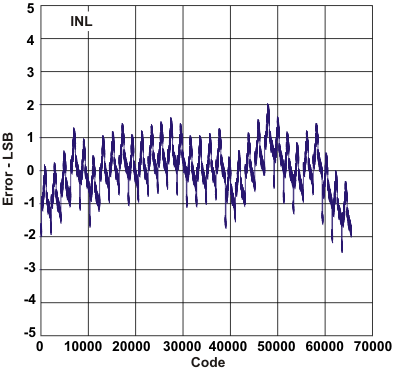 Figure 1. Integral Non-Linearity
Figure 1. Integral Non-Linearity
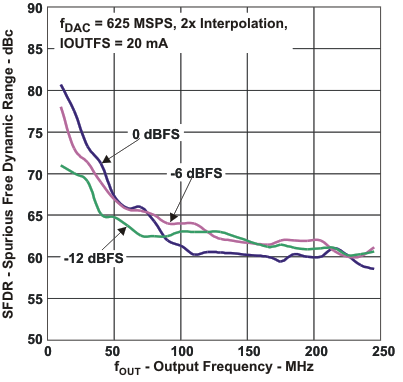 Figure 3. SFDR vs Input Scale
Figure 3. SFDR vs Input Scale
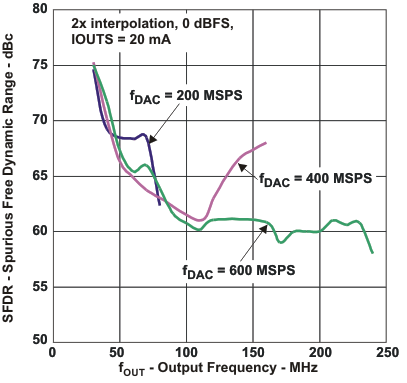 Figure 5. SFDR vs fDAC
Figure 5. SFDR vs fDAC
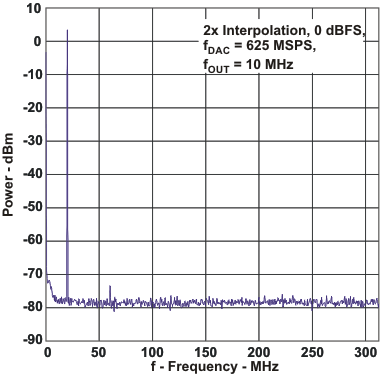 Figure 7. Single Tone Spectral Plot
Figure 7. Single Tone Spectral Plot
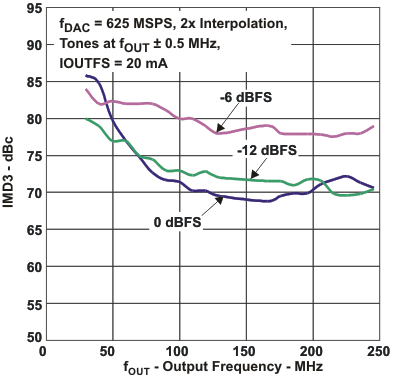 Figure 9. IMD3 vs Input Scale
Figure 9. IMD3 vs Input Scale
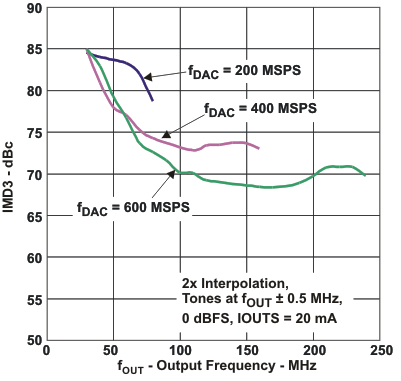 Figure 11. IMD3 vs fDAC
Figure 11. IMD3 vs fDAC
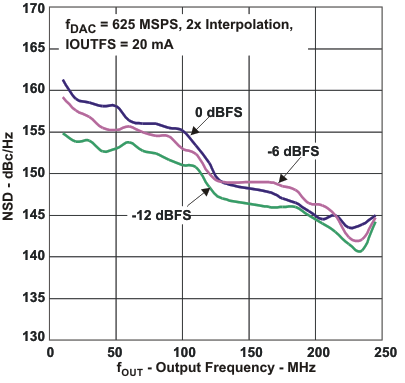 Figure 13. NSD vs Input Scale
Figure 13. NSD vs Input Scale
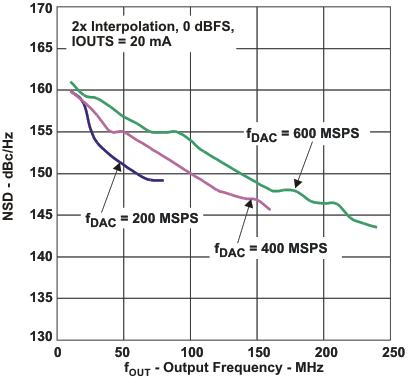 Figure 15. NSD vs fDAC
Figure 15. NSD vs fDAC
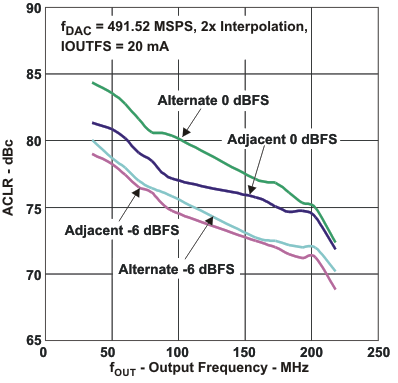 Figure 17. Single Carrier WCDMA ACLR vs Input Scale
Figure 17. Single Carrier WCDMA ACLR vs Input Scale
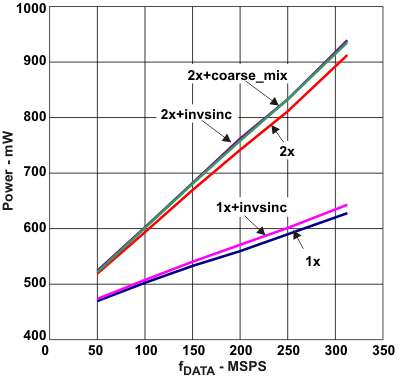 Figure 19. Power vs fDATA
Figure 19. Power vs fDATA
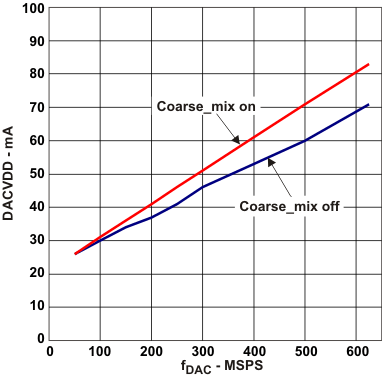 Figure 21. DACVDD18 vs fDAC
Figure 21. DACVDD18 vs fDAC
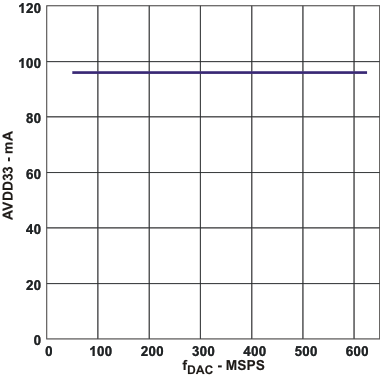 Figure 23. AVDD33 vs fDAC
Figure 23. AVDD33 vs fDAC
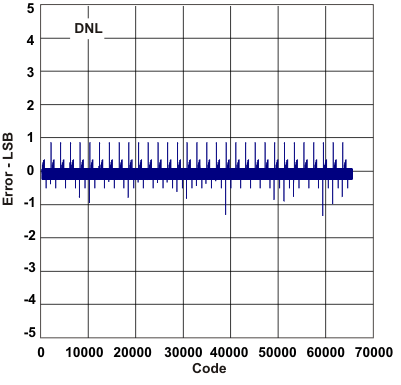 Figure 2. Differential Non-Linearity
Figure 2. Differential Non-Linearity
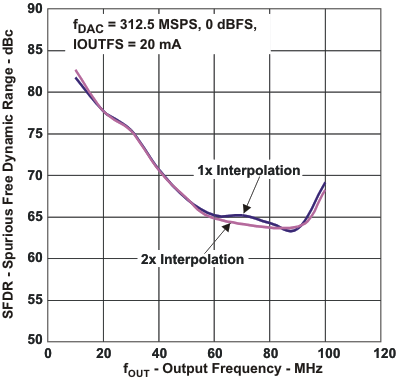 Figure 4. SFDR vs Interpolation
Figure 4. SFDR vs Interpolation
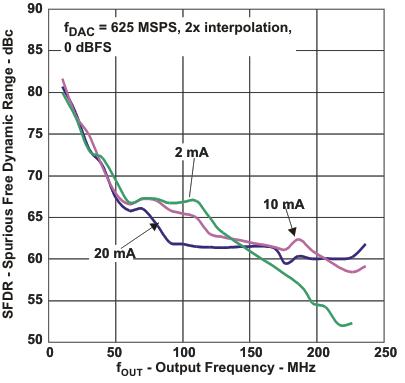 Figure 6. SFDR vs IOUTFS
Figure 6. SFDR vs IOUTFS
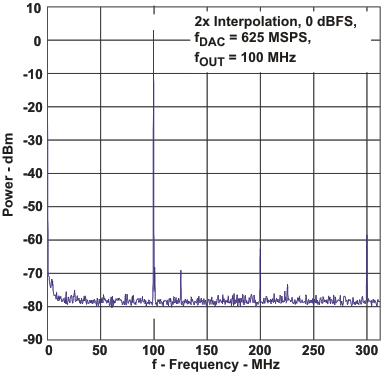 Figure 8. Single Tone Spectral Plot
Figure 8. Single Tone Spectral Plot
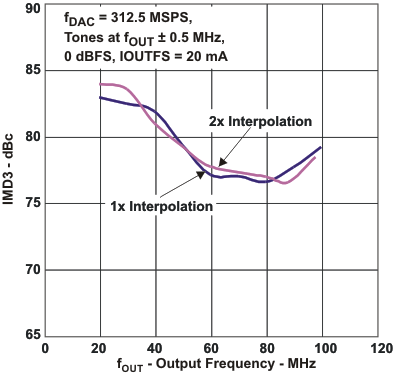 Figure 10. IMD3 vs Interpolation
Figure 10. IMD3 vs Interpolation
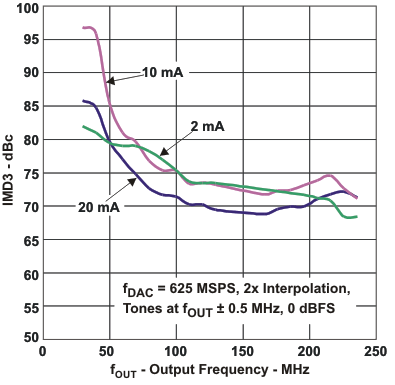 Figure 12. IMD3 vs IOUTFS
Figure 12. IMD3 vs IOUTFS
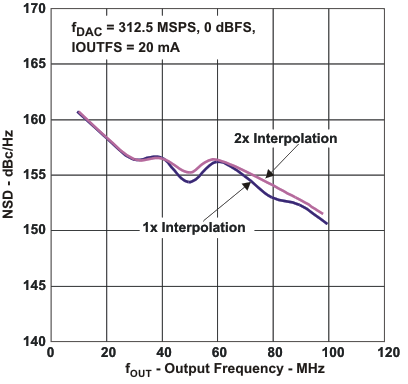 Figure 14. NSD vs Interpolation
Figure 14. NSD vs Interpolation
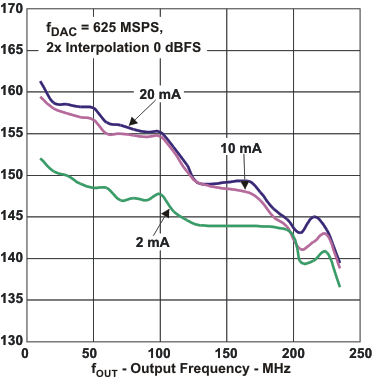 Figure 16. NSD vs IOUTFS
Figure 16. NSD vs IOUTFS
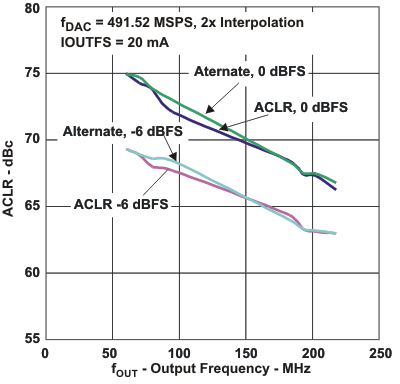 Figure 18. Four Carrier WCDMA ACLR vs Input Scale
Figure 18. Four Carrier WCDMA ACLR vs Input Scale
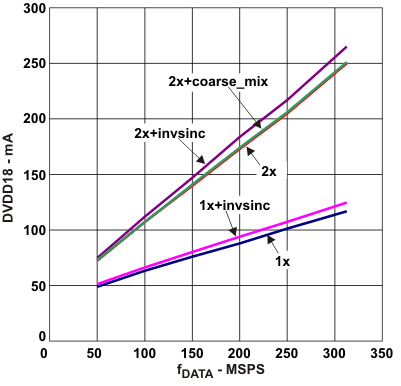 Figure 20. DVDD18 vs fDATA
Figure 20. DVDD18 vs fDATA
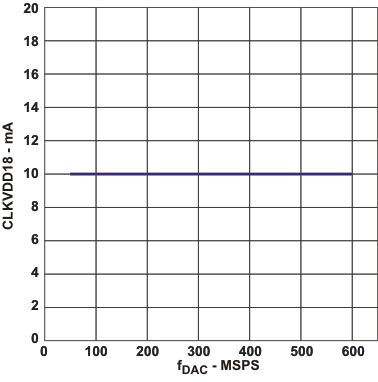 Figure 22. CLKVDD18 vs fDAC
Figure 22. CLKVDD18 vs fDAC